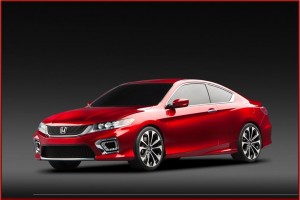Honda has sent along the first images of the all-new 2013 Accord coupe that is due this fall. Yes, the release included the timeworn cliché of “a bold, new grille.”Yawn.
What the photo reveals is a car consistent with the concept minus the bling and the larger wheels of the Accord revealed last January at the North American International Auto Show.
The ninth generation Accord, a perennial top seller in the family car category faces unprecedented competition from the Toyota Camry – the best selling car in the U.S. and all new last year – a revised Nissan Altima, as well as updated versions of the Ford Fusion and Chevrolet Malibu, among others. The category is important for its size – almost 20% of the cars sold in the U.S., and as a result, its bragging rights used in advertising.
Honda, severely hurt during the Great Recession in 2008 trimmed its research and development spending just as it was introducing in the U.S. fuel- and space- inefficient larger vehicles such as the CrossTour.
The Accord itself lagged – if you can believe it from Honda – in fuel efficiency by sticking with an older generation engine and five-speed automatic transmission.
Therefore, the new Accord needs to claw back the reputation of Honda, which along with the dubious distinction of having recalled more cars than any company in 2011 has, frankly, lost its way.
Styling aside,which is mainstream with accent lines added to rounded body and is a matter of personal taste, encouraging for traditional Honda fans is the smaller overall size of the 2013 Accord. Smaller means lighter and more efficient. Inside is said to be larger with increased passenger and cargo space in both the sedan and the coupe, another encouraging step. Quality is unknown.
The 2013 model Accord line, which among other things will see the debut of Honda’s first plug-in hybrid , will have two other substantially revised powertrains, a 2.4-liter direct-injected engine and a 3.5-liter V6 engine both mated – finally – to a new 6-speed automatic transmission.
What remains to be seen are the quality of the materials, and above all, the performance and fuel economy ratings since all the cars in the segment are showing the best fuel economy ratings in years.
A Honda program now underway called “Earth Dreams Technology,” in a very rough translation, is actually a series of efficiency and fuel economy boosting measures for engines, and transmissions, as well as electric-powered motors using existing or emerging technologies. Variable valve timing, direct injection, the Atkinson cycle, hybrid vehicles, turbocharging and friction reduction are part of the plan’s proposed techniques. (See Honda Claims it will lead in Fuel Economy in All Classes within Three Years. New EVs and Hybrids Coming) The new Accord will be a key early indicator if Honda can become efficient again.
Honda, of course, is not the only automaker to be frantically pursuing increased vehicle, engine and electric motor efficiency – whether stated publicly or not – because of ever tightening global emission and CO2 standards. (Consider another similar program, Mazda’s also dreadfully named SkyActive technology.) It is simply the price of survival. Since all of the technologies cited are well know, with many in production at other automakers, the secret to success will be which company can execute fuel efficiency improvement plans fastest at the least cost to buyers.
See: Family Car Wars Revived as Nissan Ships New 2013 Altima



